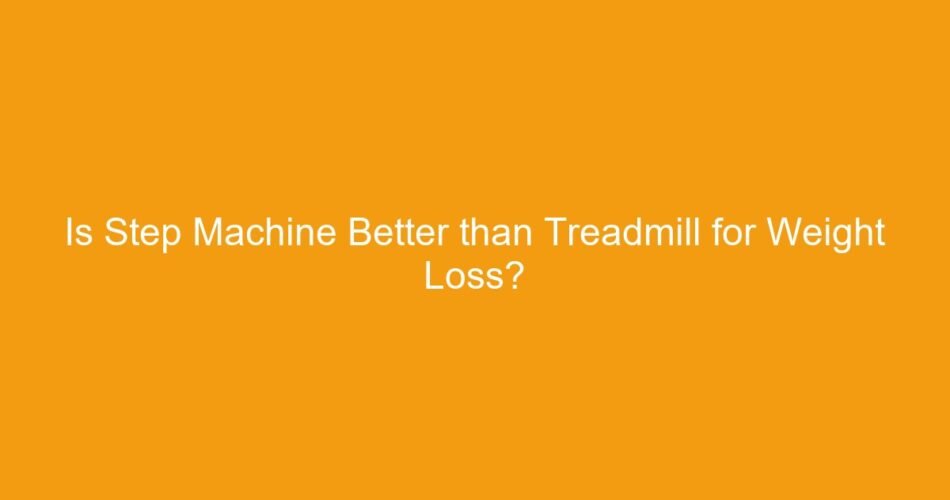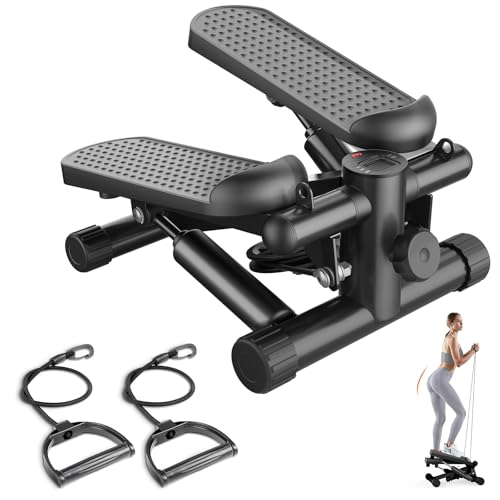Is Step Machine Better than Treadmill for Weight Loss?
If maximizing energy expenditure and lower body strength is the primary goal, the step machine (or stair climber) is often superior for weight loss compared to the treadmill because of its intense calorie burn and targeted muscle engagement.
The question Is Step Machine Better than Treadmill for Weight Loss? requires a focused answer based on intensity, muscle recruitment, and versatility. For pure caloric output and high metabolic demand, the step machine typically edges out the treadmill when both are used at peak intensity for a comparable duration. However, the treadmill offers greater variety in movement (walking, jogging, running) and is often more suitable for users concerned about joint impact or those prioritizing long-duration steady-state cardio.
🛒 Recommended Product
Calorie Burn and Metabolic Rate
The primary metric for weight loss success is a sustained calorie deficit. Both machines are effective cardiovascular tools, but the motion required by the step machine inherently demands more effort from the larger muscle groups, resulting in a higher potential energy expenditure.
The stepping motion mimics climbing stairs, which is a load-bearing exercise that constantly fights gravity. This leads to higher activation of the posterior chain (glutes and hamstrings).
- Step Machine (Stair Climber): A 150-pound individual can burn approximately 600–750 calories per hour at a vigorous pace. This high burn rate is driven by the consistent need to lift the body weight against resistance.
- Treadmill (Running): The same individual running at a brisk 6 mph pace burns roughly 550–650 calories per hour. While running is full-body, the effort is distributed, and the belt assists slightly with forward momentum.
Key Fact: Research often supports the finding that exercises requiring high vertical displacement and constant weight loading—like stair climbing—activate a greater number of muscle fibers per minute, boosting the immediate Metabolic Equivalent of Task (METs) value and leading to superior fat burning potential during the workout itself.
Muscle Engagement and Intensity
When determining the better machine, consider which muscle groups are most engaged. The step machine focuses almost exclusively on building and utilizing the power muscles of the lower body, while the treadmill provides a balanced workout suitable for general cardiovascular fitness.
The Step Machine Advantage
The motion of a stair climber is highly specific. Because the foot never leaves the pedal (or platform), there is constant tension.
- Glutes and Hamstrings: The step machine requires maximum hip extension to push the foot down, making it excellent for targeting the largest fat-burning muscles in the body. Developing these muscles boosts basal metabolic rate even when resting.
- Core Stability: Maintaining balance and posture while stepping at a high rate engages the core muscles more effectively than steady running on a flat treadmill surface.
The Treadmill Advantage
The treadmill is unmatched in its ability to simulate real-world movement and accommodate various fitness levels and workout styles.
🛒 Recommended Product
- Versatility: The treadmill allows for incline walking (great for calorie burn and low impact), jogging, running, and high-intensity interval training (HIIT) that incorporates sprints. This versatility helps prevent plateaus, a common hurdle in a long-term weight loss journey.
- Muscle Focus: While the step machine targets the glutes, the treadmill (especially running) provides stronger recruitment of the quadriceps and calf muscles.
Versatility, Joint Impact, and Exercise Preference
Ultimately, the best machine is the one you will use consistently. Both machines have distinct benefits regarding ease of use and long-term sustainability.
Joint Impact and User Suitability
A common concern when evaluating the step machine vs treadmill for weight loss is impact.
| Feature | Step Machine (Stair Climber) | Treadmill (Running) |
|---|---|---|
| Calorie Burn Potential | Higher (due to constant load) | High (dependent on speed/incline) |
| Primary Muscle Focus | Glutes, Hamstrings, Calves | Quads, Calves, Glutes |
| Joint Impact | Low Impact (Weight bearing, but no striking) | Moderate to High Impact (Running) |
| Versatility | Limited range of motion; consistent resistance | Highly versatile (Walk, Run, Incline, HIIT) |
| Ideal User | Those seeking strength/toning and maximum burn | Those seeking general cardio endurance and variety |
The step machine is often considered low-impact because the feet never leave the pedals, eliminating the jarring shock of foot-strikes characteristic of running. This makes the step machine an excellent choice for individuals with sensitive knees or joints looking to maintain aggressive calorie expenditure without risk of injury.
High-Intensity Interval Training (HIIT)
Both machines are highly effective for implementing HIIT, which maximizes calorie burn and increases the Excess Post-exercise Oxygen Consumption (EPOC)—the afterburn effect that continues to torch calories post-workout.
On the step machine, HIIT involves short bursts of climbing at maximum speed, followed by slow recovery periods. On the treadmill, this means intense sprinting followed by recovery jogging or walking. Due to the high resistance, the step machine can often push the heart rate into the fat-burning zone faster than moderate treadmill work.
Final Determination
If the goal is to identify which machine offers the highest potential for rapid calorie burn and lower body muscle development, the answer is usually the step machine. Its design forces the user into constant resistance against gravity, leveraging large muscle groups for maximum energy expenditure per minute.
🛒 Recommended Product
However, the question Is Step Machine Better than Treadmill for Weight Loss? cannot ignore consistency. The treadmill’s superior versatility, lower cognitive demand, and ability to handle long, steady-state cardio sessions mean many users find it easier to stick with for months or years. For maximum sustainable weight loss, the machine that fits your fitness level, addresses your injury concerns, and inspires consistent use is the definitive best choice.
Scientific References & Research
The following peer-reviewed research papers provide additional scientific context:
-
F Mekki (2021).
Two-step machine learning enables optimized nanoparticle synthesis
[External Link] -
TM Cook et al. (1992).
EMG comparison of lateral step-up and stepping machine exercise
[External Link] -
AD Kuo (2007).
Choosing your steps carefully
[External Link]
Note: External research links are provided for educational purposes and do not necessarily represent endorsement.
Frequently Asked Questions About Is Step Machine Better than Treadmill for Weight Loss?
Q. Is the low-impact nature of the step machine a significant advantage over the treadmill for individuals prioritizing weight loss while managing joint health?
A. Yes, the step machine offers a significantly lower-impact workout than running on a treadmill, making it advantageous for individuals who are overweight or have pre-existing joint issues like knee or ankle pain. This reduced impact allows users to maintain longer or more frequent workout sessions necessary for achieving a caloric deficit without risking injury flare-ups that could derail their weight loss efforts. The treadmill, even when walking, still imparts more jarring forces on the joints than the contained vertical movement of the stepper.
Q. Which machine, the step machine or the treadmill, is better suited for building muscle mass alongside achieving weight loss?
A. The step machine, particularly a stair climber or high-resistance stepper, is superior for building lower-body muscle mass—specifically the glutes, hamstrings, and calves—due to the sustained concentric and eccentric contractions against resistance. While the treadmill is excellent for pure cardio and endurance, it offers minimal resistance training; therefore, the step machine better supports the goal of body recomposition by preserving or building muscle while losing fat.
Q. Regarding metabolic rate, does the higher intensity potential of the treadmill or the greater localized muscle engagement of the step machine offer a better post-exercise benefit (EPOC) for weight loss?
A. The higher-intensity options available on the treadmill, such as sprinting or steep incline running, typically generate a greater Excess Post-exercise Oxygen Consumption (EPOC) effect, meaning more calories are burned after the workout is complete. However, the step machine’s intense engagement of large muscle groups at moderate to high resistance also produces a substantial EPOC effect, especially if used for high-intensity interval training (HIIT). Overall, the machine that allows the user to push their maximum effort will generate the best post-exercise benefit.
Q. How does workout variability influence long-term adherence and weight loss success when comparing the step machine and the treadmill?
A. The treadmill generally offers more variability in exercise modalities, allowing users to switch between walking, jogging, running, and adjusting inclines, which can prevent boredom and promote long-term adherence necessary for sustained weight loss. While modern step machines offer different programs, the movement pattern is inherently more repetitive than the treadmill’s versatility. Therefore, individuals struggling with exercise monotony might find the treadmill better for maintaining consistency over many months.
Q. For individuals who are severely deconditioned or obese, which machine provides a safer and more manageable entry point into cardiovascular exercise for weight loss?
A. For severely deconditioned or obese individuals, the treadmill often provides a safer starting point because they can easily control the speed and simply walk, allowing their body to adjust to movement without the complexity of managing resistance. Although the step machine is low-impact, the constant need to lift body weight against gravity can be taxing on the cardiovascular system and muscular endurance initially. A slow-paced, zero-incline walk on the treadmill is generally the most accessible starting activity.
Q. Considering core engagement, which machine offers better benefits for strengthening the torso, contributing to better posture and supporting weight loss efforts?
A. The step machine tends to require slightly more intrinsic core stabilization than a treadmill because the user must actively maintain balance and an upright posture while the lower body moves independently. While the treadmill allows some users to lean heavily on the handrails, proper stepping technique on a stepper discourages leaning and forces the core muscles to engage to stabilize the trunk and prevent lateral sway. Better core strength supports improved exercise form and potentially greater overall weight loss performance.
Related Articles
Do Weight Loss Vibration Machines Work?
Vibration machines alone are not magic diet tools Do Weight Loss Vibration Machines Work The consensus from clinical trials suggests they are effectiv…
Do Rowing Machines Help with Weight Loss?
Do Rowing Machines Help with Weight Loss? Rowing machines are an outstanding tool for significant weight loss, uniquely combining high-intensity cardi…
Do Elliptical Machines Work for Weight Loss?
Ellipticals offer a powerful, low-impact solution for achieving aggressive weight management goals. Find out exactly how many calories you can burn an…
When you purchase a product through Amazon links on EllipticalKing.com, we may earn a small commission at no extra cost to you. This helps support the site and keep our content free.




